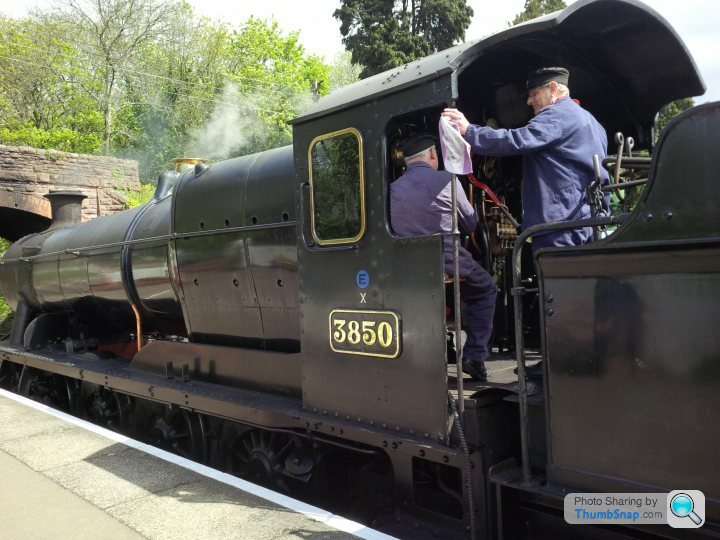Driving a Steam Engine
Discussion
RichB said:
Did GWR really use such rubbish? I always heard they only ran on choice Welsh coal. Or at least that's what the CMEs of other railways used to say when their precious Pacifics were beaten in the head-to-head trials by smaller 4-6-0s 
Everything changed post-WW2. The country was virtually bankrupt, anything decent that the UK could make or dig out of the ground was going for export, and Blighty was left with the rubbish. The chances are that the railway couldn't have afforded decent coal by then, even if they could get hold of it.
That's why so much work was done on modifying and improving steam engine performance during the 50s by such people as Sam Ell at Swindon, despite the fact that it was clear to anybody with half a brain that diesels were the way forward. Steam was still going to be around for some time, and they had do to something to make the buggers work when trying to burn cement and fag ash.
It is said by some that the Bullied pacifics would steam with a candle in the firebox, and that might have been true when you got them rolling. There was however a documented case where one of them stalled on Parkstone bank between Poole and Bournemouth, and was rescued by a Black 5 on an S&D train - hauling its own 10 coaches and pushing the Bullied and its train at the same time...
Steaming on a candle is OK under certain circumstances. In others, you need a proper engine to get the job done...

W124Bob said:
I've been lucky enough to work with drivers old enough to drive steam, we still have one at my depot who's stayed on abit. It still fills me with admiration for the job they did as it was bloody hard, dirty and dangerous. The correct way to cook on the shuffle is to get it very hot in the firebox then take it out, good dose of lard and then cook on the residue heat. Another favourite of some crews was an onion wrapped in tinfoil resting on a hot pipe, leave to cook for an hour or so then serve with butter and salt.
I used to work with a former fireman (called, believe or not, Gordon Bennett), anyway, after he told me what shovels were used for in steam days, I wouldn't eat food that's been anywhere near one.RichB said:
Did GWR really use such rubbish? I always heard they only ran on choice Welsh coal. Or at least that's what the CMEs of other railways used to say when their precious Pacifics were beaten in the head-to-head trials by smaller 4-6-0s 
I will say having fired Russian, Polish and Welsh coal, that Welsh burns extremely well, and probably has around a third more energy per pound than the Russian and Polish stuff. However, because it doesn't have much in the way of volatiles, it can be a bugger to get burning in the first place. The other stuff will light almost the moment it leaves the shovel, under almost any circumstances - the Welsh stuff requires forethought and planning. Even in a white-hot fire with the engine working extremely hard, it'll still sit in the firebox brewing up for a minute or two before it ignites. 
A machine designed to work with such a fuel (like the Stars, Castles and Kings) will of course be able to maintain exceptional steaming/evaporation rates relative to their size. If I remember correctly, in the 1925 trials the Castle did indeed perform better than the A1, but it wasn't burning the relatively poor grade coal the A1 was using. At that point in 1925 the GWR certainly had one of the finest locomotive designs in the country, but they rather relaxed after that, whereas the other companies carried on with development.
rs1952 said:
mrmaggit said:
I was surprised just how small the firebox door was. My other halfs Dad was a fireman at Colwick, but left when steam was finished.
None of them were particularly big and for a good reason - when they are open for firing they let a lot of unwanted cold air into the firebox - but some were smaller than others.A friend of mine who was a fireman at Bristol Barrow Road in the late 50s and early 60s tells of how it was more of an art to get the coal in through the door of a B1 when they had one of those to take somewhere, rather than the Midland/ LMS engines they were more used to, which had a larger opening.
By the way - Colwick closed in December 1966 linky, which therefore gives us a clue as to the age of your FIL and your other half

Well we had a great day in Somerset on Tuesday, 3850 on a freight train running up and down the 20 miles between Minehead and Bishops Lydeard crossing over with the passenger services in the station passing loops. Some running forwards and some tender first, all in all about 8 hours on the tracks. Even the weather was reasonably kind too. 





Gassing Station | Boats, Planes & Trains | Top of Page | What's New | My Stuff



